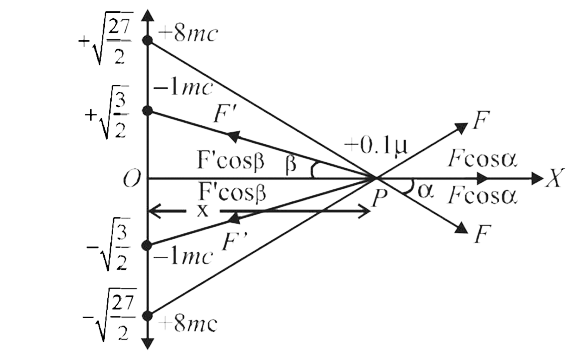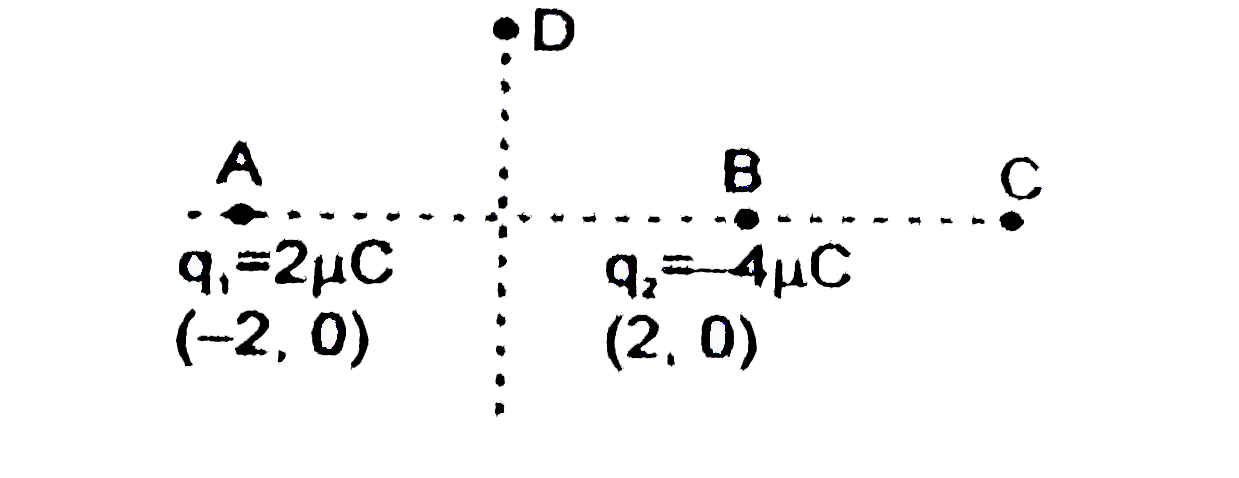Four point charges +8mC, −mC, and +8mC are fixed at the points −√272m, −√32m, +sqrt(3/2)mand+sqrt(27/2)mrespectivelyonthey−aξs.Apartic≤ofmass6xx10^-4kgandchar≥+0.1muCmovesalongthe−xdirection.Itsspeedatx=+ooisV_0.F∈dthe≤∗valueofV_0forwhichthepartic≤willcrosstheorig∈.F∈dalsothek∈etice≠rgyofthepartic≤attheorig∈.As∑etˆspaceisgravityee.<br>Given(1)/(4piepsilon_0)=9xx10^9Nm^2//C^2.
The correct Answer is:A, C, D
Let the particle at some instant be at a point P distant x from the origin. As shown in the figure, there are two forces of repulsion acting due to two charges of +8 mC. The net force is 2Fcosα towards light.
Similarly there are two forces of attraction due to two charges of −1mC. The net force due to these force is 2Fcosβ towards left.

The net force on charge 0.1μC is zero when
2Fcosα=2F′cosβ
K×8×10−6×0.1×10−6(√x2+272)2×x√x2+272
=K×1×10−6×0.1×10−6(√x2+32)2×x√x2+32
⇒x=±√52
This means that we need to move the charge from −∞ to √52 . Thereafter the attractive forces will make the charge move to origin.
The electric potential of the four charges at x=√52 is
V=2×9×109×8×10−6√52+272-(2xx9xx10^9xx10^-6)/(sqrt(5/2)+3/2)<br>=2xx9xx10^9xx10^-6[8/4-1/2]=2.7xx10^4V<br>K∈etice≠rgyisrequired→overcometheforceofreps–ionomprop→x=sqrt(5/2).<br>Theworkdo≠∈thisprocessisW=q(V)<br>whereV=p.dbetweenooandx=sqrt(5/2).<br>:.W=0.1xx10^-6xx2.7xx10^4=2.7xx10^-3J<br>Bye≠rgyconservation1/2mV_0^2=2.7xx10^-3<br>implies 1/2xx6xx10^-4V_0^2=2.7xx10^-3<br>implies V_0=3m//s<br>K.E.attheorig∈<br>Potentialatorig∈V_(x=0)=(2xx9xx10^9xx8xx10^-6)/(sqrt(27/2))-(2xx9xx10^9xx10^-6)/(sqrt(3/2))<br>=2.4xx10^4<br>Aga∈bye≠rgyconservation<br>K.E. =q[V_(x=(sqrt5)/(2))-V_(x=0)]<br>:.K.E.=0.1×10−6[2.7×104−2.4×104]
=0.1×10−6×0.3×104
=3×10−4J
Related Playlists
- BOOK - SUNIL BATRA (41 YEARS IITJEE PHYSICS)CHAPTER - ELECTROSTATICSEXERCISE - Comprehension Based Questions2videos
ELECTROSTATICS
- BOOK - SUNIL BATRA (41 YEARS IITJEE PHYSICS)CHAPTER - ELECTROSTATICSEXERCISE - Comprehension Based Questions2videos
ELECTROSTATICS
- BOOK - SUNIL BATRA (41 YEARS IITJEE PHYSICS)CHAPTER - ELECTROMAGNETIC INDUCTION AND ALTERNATING CURRENTEXERCISE - JEE Main And Advanced107videos
ELECTROMAGNETIC INDUCTION AND ALTERNATING CURRENT
- BOOK - SUNIL BATRA (41 YEARS IITJEE PHYSICS)CHAPTER - MODERN PHYSICSEXERCISE - MCQ (One Correct Answer1videos
MODERN PHYSICS
Similar Questions
Four point charges +8μC,−1μC,−1μC and , +8μC are fixed at the points −√27/2m,−√3/2m,+√3/2m
and +√27/2m respectively on the y-axis. A particle of mass 6×10−4kg and +0.1μC moves along the x-direction. Its speed at x=+∞ is v0. find the least value of v0 for which the particle will cross the origin. find also the kinetic energy of the particle at the origin in tyhis case. Assume that there is no force part from electrostatic force.View SolutionFour point charges +8μC,−1μC,−1μC and , +8μC are fixed at the points −√27/2m,−√3/2m,+√3/2m
and +√27/2m respectively on the y-axis. A particle of mass 6×10−4kg and +0.1μC moves along the x-direction. Its speed at x=+∞ is v0. find the least value of v0 for which the particle will cross the origin. find also the kinetic energy of the particle at the origin in tyhis case. Assume that there is no force part from electrostatic force.View SolutionFour point +8μC,−1μC,−1μC, and +8μC are fixed at the points −√27/2m,−√3/2m,+√3/2m, and +√27/2m, respectively, on the y - axis. A particle of mass 6×10−4kg and charge +0.1μC moves along the x- direction. Its speed at x=+∞ is V0. Find the least value of V0 for which the particle will cross the origin. Find also the kinetic energy of the particle at the origin. Find also the kinetic energy of the particle at the origin. Assume that space is gravity free. Given (1/4πε0)=9×109Nm2C−2.
View SolutionFour point charges +8μC,−1μC,−1μC and , +8μC are fixed at the points −√27/2m,−√3/2m,+√3/2m
and +√27/2m respectively on the y-axis. A particle of mass 6×10−4kg and +0.1μC moves along the x-direction. Its speed at x=+∞ is v0. find the least value of v0 for which the particle will cross the origin. find also the kinetic energy of the particle at the origin in tyhis case. Assume that there is no force part from electrostatic force.View SolutionFour point charges q, -2q, -q and 2q are placed at points (0,0,0) m , (√2,0,0)m,(√2,√2,0)m and (0,√2,0) m respectively . The electric field at point (1√2,1√2,0)m is (q=1μC)
View Solutiontwo point charges 2μC and −4μC are situated at points (−2m,0m) and (2m,0m) respectively. Find out potential at point C(4m,0m) and D(0m,√5m).
 View Solution
View Solutiontwo point charges 2μC and −4μC are situated at points (−2m,0m) and (2m,0m) respectively. Find out potential at point C(4m,0m) and D(0m,√5m).
 View Solution
View SolutionA particle of mass m=5kg is moving with a uniform speed v=3√2 in the XOY plane along the line Y=X+4. The magnitude of the angular momentum of the particle about the origin is
View SolutionA particle of mass 2 g and charge 1μC is held at rest on a frictionless surface at a distance of 1m from a fixed charge of 1 mC. If the particle is released it will be repelled. The speed of the particle when it is at distance of 10 m from fixed charge is :
View SolutionA particle of mass 2 g and charge 1μC is held at rest on a frictionless surface at a distance of 1m from a fixed charge of 1 mC. If the particle is released it will be repelled. The speed of the particle when it is at distance of 10 m from fixed charge is :
View Solution

